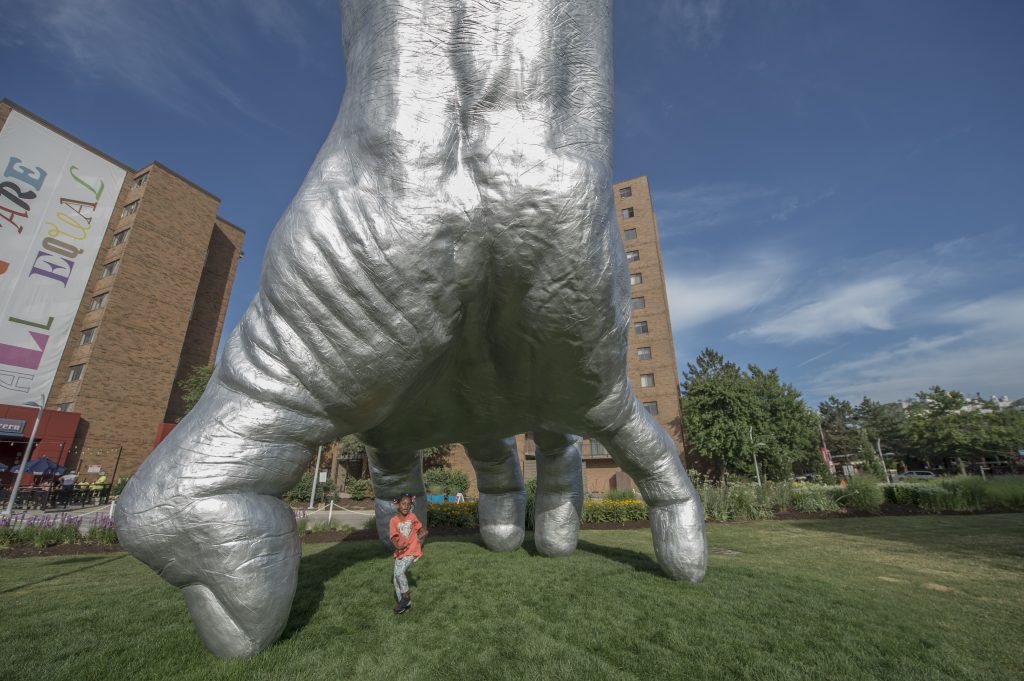Art World
Cleveland’s Inaugural FRONT Triennial Generated an Estimated $31 Million for the Region, Study Finds
The organizers hope the study will provide a benchmark for the economic impact of regional biennials.

The organizers hope the study will provide a benchmark for the economic impact of regional biennials.

Taylor Dafoe

Regional biennials and triennials have popped up all over the country over the past decade, from Kansas City to Portland to Honolulu. Meanwhile, the art world has become increasingly wary—and weary—of this proliferation of festivals. The skepticism makes sense, given that we have little to no means of understanding or measuring the impact of these events.
One of the more recent additions to the art calendar, the FRONT International: Cleveland Triennial for Contemporary Art, which just wrapped up its ambitious inaugural edition this fall, is now seeking to quantify its impact. FRONT commissioned the Center for Economic Development at Cleveland State University (CSU) to conduct a report, studying the cost, attendance, and profits generated by the event across its 26 different sites.
What researchers found was quite positive. The first FRONT Triennial brought in an estimated $31 million in revenue to the Northeast Ohio region, they estimated, directly employing 735 people across all of its sites. Institutions that mounted exhibitions during the run of FRONT—both those included in the triennial and not—netted roughly $115 million in revenue, supplying an additional $8 million in state and local taxes.
“FRONT is sort of an experiment that hasn’t been done before,” Fred Bidwell, the executive director of FRONT, tells artnet News. “We had several questions that needed to be answered: Could you justify the investment? Would people from the art world hubs go to a smaller city to participate in an event like this? I think the answer to both is a resounding yes.”

Fred Bidwell (third from the left) at the FRONT International ribbon-cutting ceremony. Courtesy of FRONT International: Cleveland Triennial for Contemporary Art.
While it’s hard to find a direct comparison for economic impact numbers in the art world, Bidwell points to the 2016 Republican National Convention, held in Cleveland, as a helpful yardstick. The convention—which, by its nature, is likely to draw a much bigger audience than a semi-annual art event—brought in $188 million to the region, with $61 million of that translating to income for residents.
Another comparison not mentioned by FRONT: Pacific Standard Time: LA/LA, the Getty-funded collaboration among 70 institutions in Southern California, which contributed roughly $430.3 million to the region’s economy between September 2017 and January 2018, according to a study by the Los Angeles County Development Corporation. (To be fair, FRONT was just under three months while PST stretched over five months and across a much larger geographic area.)
Like any study measuring economic impact, FRONT’s is part art, part science. The researchers made a number of assumptions: they estimated a nightly stay in a hotel as a flat $125 per person per night (and did not factor in those who may have shared a room). They also based attendance figures on the total attendance at each venue, despite the fact that they estimate that just 20 percent of that attendance was exclusively due to FRONT during the period they examined.
In the end, the study concluded that FRONT brought in over 227,000 total visits. On average, guests saw the show 2.5 times each—including stops at various locations—making 90,000 of those visits unique. Thirty-five percent of visitors came from outside the region, a number that ballooned to 54 percent on the opening weekend in July.
That’s one area that could use improvement, Bidwell notes—he’d like to eventually increase the number of locals attending. He also expressed a desire to know more about the demographics of the visitorship, an area that was not addressed in detail by the CSU study.
“The possible knock on anything in the art world is, ‘Oh, well this just appeals to the elite,’” he says. “In a city like Cleveland, it can’t be just about the elite. It has to reach every levels of the community.”
Still, Bidwell maintains, the event was a step in the right direction.
“For the past 30 years, Cleveland has lived under the weight of that aging rust belt city stereotype. FRONT is part of an effort to change that dialogue. I can’t say we can declare victory after one edition, but I definitely think it moved the needle forward in terms of the reputation of the city and its institutions.”